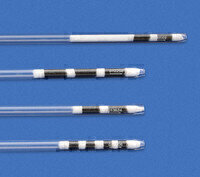Environmental Laboratory
Mercury monitoring via sorbent trap
Oct 27 2015
Our Mercury Sampler has been designed especially for performing periodic or long term vapour phase mercury sampling via sorbent trap.
The sorbent tube system is very simple to use, as has been demonstrated during worldwide trials and is the method of choice in the USA, as set out in USEPA 30b and 12b. The EU Industrial Emissions Directive (IED) will call for annual monitoring of mercury beyond 2016 and, as set down in the new BREF documents requirements, this will require more frequent mercury monitoring and control on some plants. For many plants, the sorbent tube method will be both simpler and more cost effective solution.
The MercSampler simplifies sampling requirements by automating data acquisition, sample flow adjustments, leak checks, calculations, temperature control, and calibrations. Data is easily transferred to a Microsoft Windows Based PC through USB Interface. The MercSampler performs dual sorbent trap sampling at flow rates up to 2.0 lpm. It can be operated with your choice of mercury probes and gas conditioning systems, including our popular SGC-4000HGP Stirling Gas Conditioner.
Features include:
- Fully automated for paired sampling
- Dual dry gas meters and mass flow sensors
- Alerts for port and traverse point changes
- Simple data export
- Compact portable system
- Eight isolated type K thermocouple channels
- USB interface
- Easily configured with Windows based PC.
The MercSampler console was designed and configured to meet requirements for multiple applications; primarily Mercury sampling, but can also be used with European, International and USEPA methods.
Here are some of the end-user benefits that have been shared with us.
- Ease of operation - The simplicity of sorbent trap monitoring over other technologies is significant. With budgets constantly being reduced, sorbent trap monitoring often only required 30 minutes a week of a field technicians time compared with over 30 minutes a day for other technologies. With environmental departments being asked to do more with less, sorbent trap sampling is often received as a welcomed alternative to the complicated, labour intensive operation of other environmental sampling equipment.
- Ease of installation - The sorbent trap system is easy to install and much more robust than other options available for mercury emissions monitoring. The simple, proven technology used to perform sorbent trap sampling tends to handle the unforgiving conditions these systems often find themselves installed, more so than other technologies that use much more sensitive componentry.
- Cost - With sorbent trap monitoring systems often costing less than half the price of other monitoring options, sorbent trap monitoring is a cost effective way to monitor mercury emissions. Cost savings are also seen in the reduced labour needed to run the system as well as operating and repair costs.
- Multiple configuration options - Mercury Sorbent trap systems can be configured in several ways to accommodate any site specific challenges with little or no costly changes to existing infrastructure. Configurations can be designed from having all of the sampling equipment located at the sampling location to extracting the sample and bringing it down to an existing shelter for moisture knock-out and volumetric gas reading.
- Reliability - With regulatory agencies requiring a steady supply of sample reporting data, reliability in any sampling system is essential as down-time can often result in penalties or fines. The simple sampling principles of sorbent trap sampling lend themselves to be more easily troubleshot and repaired in the field by operators who can be trained within only a few days. The modular design of the sorbent trap sampling system also allows for components to be replaced in the field, minimising down-time.
- Ease of maintenance - Sorbent trap sampling technology is based on simple proven technology that in-turn requires simple auditing and calibration procedures to keep the system in valid working condition. Unlike complex real-time mercury monitoring systems that require daily maintenance and costly calibrations/carrier gases, sorbent trap technology requires simple leak checks when traps are changed and quarter audits using reference devices that most operators are already familiar with.
When monitoring technology is cheap and simple to use, not only does it motivate the operators of this equipment to become more proficient at operating and troubleshooting the equipment, it also provides more reliable sample data due to the fact that there is more trust the equipment is operating correctly and any operating issues can be resolved with more confidence that the equipment is back to the operating standard.
With over 20 years’ experience in the Emission testing, equipment design, manufacturing and distribution of source sampling equipment for measuring emissions to international, European and US EPA guidelines, including gaseous/isokinetic methods and mercury sorbent trap sampling. We will have the solution to your sampling requirements
Digital Edition
IET 34.2 March 2024
April 2024
Gas Detection - Biogas batch fermentation system for laboratory use with automatic gas analysis in real time Water/Wastewater - Upcycling sensors for sustainable nature management - Prist...
View all digital editions
Events
Apr 30 2024 Melbourne, Australia
Apr 30 2024 Birmingham, UK
May 03 2024 Seoul, South Korea
May 05 2024 Seville, Spain
May 06 2024 Minneapolis, MN, USA


















